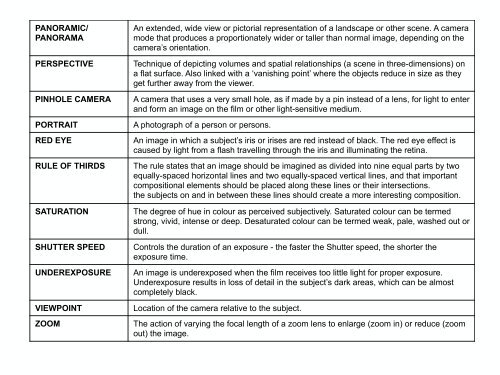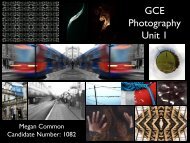GCSE Photography
Lesson Objectives and Outcomes for GCSE Photography Coursework Projects
Lesson Objectives and Outcomes for GCSE Photography Coursework Projects
Create successful ePaper yourself
Turn your PDF publications into a flip-book with our unique Google optimized e-Paper software.
PANORAMIC/<br />
PANORAMA<br />
PERSPECTIVE<br />
PINHOLE CAMERA<br />
PORTRAIT<br />
RED EYE<br />
RULE OF THIRDS<br />
SATURATION<br />
SHUTTER SPEED<br />
UNDEREXPOSURE<br />
VIEWPOINT<br />
ZOOM<br />
An extended, wide view or pictorial representation of a landscape or other scene. A camera<br />
mode that produces a proportionately wider or taller than normal image, depending on the<br />
camera’s orientation.<br />
Technique of depicting volumes and spatial relationships (a scene in three-dimensions) on<br />
a flat surface. Also linked with a ‘vanishing point’ where the objects reduce in size as they<br />
get further away from the viewer.<br />
A camera that uses a very small hole, as if made by a pin instead of a lens, for light to enter<br />
and form an image on the film or other light-sensitive medium.<br />
A photograph of a person or persons.<br />
An image in which a subject’s iris or irises are red instead of black. The red eye effect is<br />
caused by light from a flash travelling through the iris and illuminating the retina.<br />
The rule states that an image should be imagined as divided into nine equal parts by two<br />
equally-spaced horizontal lines and two equally-spaced vertical lines, and that important<br />
compositional elements should be placed along these lines or their intersections.<br />
the subjects on and in between these lines should create a more interesting composition.<br />
The degree of hue in colour as perceived subjectively. Saturated colour can be termed<br />
strong, vivid, intense or deep. Desaturated colour can be termed weak, pale, washed out or<br />
dull.<br />
Controls the duration of an exposure - the faster the Shutter speed, the shorter the<br />
exposure time.<br />
An image is underexposed when the film receives too little light for proper exposure.<br />
Underexposure results in loss of detail in the subject’s dark areas, which can be almost<br />
completely black.<br />
Location of the camera relative to the subject.<br />
The action of varying the focal length of a zoom lens to enlarge (zoom in) or reduce (zoom<br />
out) the image.




